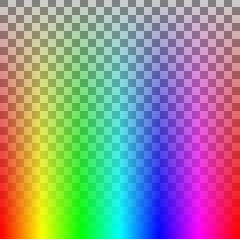RGBA color space

RGBA stands for red green blue alpha. While it is sometimes described as a color space, it is actually the combination of an RGB color model with an extra 4th alpha channel. Alpha indicates how opaque each pixel is and allows an image to be combined over others using alpha compositing, with transparent areas and anti-aliasing of the edges of opaque regions.
The term does not define what RGB color space is being used. It also does not state whether or not the colors are premultiplied by the alpha value, and if they are it does not state what color space that premultiplication was done in. This means more information than just "RGBA" is needed to determine how to handle an image.
To further confuse the issue, in some contexts the term "RGBA" means a specific layout in memory of the four channels, with other terms such as "BGRA" used for alternatives. In other contexts the alternatives are used more often but the term "RGBA" means any layout.
Representation
In computer graphics, pixels encoding the RGBA color space information must be stored in computer memory (or in files on disk), in well defined formats. There are several ways to encode RGBA colors, which can lead to confusion when image data is exchanged. These encodings are often denoted by the four letters in some order (e.g. RGBA, ARGB, etc.). Unfortunately, the interpretation of these 4-letter mnemonics is not well established, leading to further confusion. There are two typical ways to understand a mnemonic such as "RGBA":
- In the byte-order scheme, "RGBA" is understood to mean a byte R, followed by a byte G, followed by a byte B, and followed by a byte A. This scheme is commonly used for describing file formats or network protocols, which are both byte-oriented.
- In the word-order scheme, "RGBA" is understood to represent a complete 32-bit word, where R is more significant than G, which is more significant than B, which is more significant than A. This scheme can be used to describe the memory layout on a particular system. Its meaning varies depending on the endianness of the system.
In a big-endian system, the two schemes are equivalent. This is not the case for a little-endian system, where the two mnemonics are reverses of each other. Therefore, to be unambiguous, it is important to state which ordering is used when referring to the encoding.
| Format | As byte-order | As word-order | ||
|---|---|---|---|---|
| Little-endian | Big-endian | Little-endian | Big-endian | |
| RGBA (byte-order) | RGBA8888 | ABGR32 | RGBA32 | |
| ARGB (word-order) | BGRA8888 | ARGB8888 | ARGB32 | |
| RGBA (word-order) | ABGR8888 | RGBA8888 | RGBA32 | |
| ABGR (word-order) | RGBA8888 | ABGR8888 | ABGR32 | |
RGBA (byte-order)
In OpenGL and Portable Network Graphics (PNG), the RGBA (byte-order) is used, where the colors are stored in memory such that R is at the lowest address, G after it, B after that, and A last. On a little endian architecture this is equivalent to ABGR (word-order).[1]
Even when there are more than 8 bits per channel (such as 16 bits or floating-point), the channels are still stored in RGBA order. In PNG, the channels are stored as 16-bit integers in network order (big-endian).
ARGB (word-order)
In the ARGB (word-order) encoding the intensity of each channel sample is defined by 8 bits, and are arranged in memory in such manner that a single 32-bit unsigned integer has the alpha sample in the highest 8 bits, followed by the red sample, green sample and finally the blue sample in the lowest 8 bits:

ARGB values are typically expressed using 8 hexadecimal digits, with each pair of the hexadecimal digits representing the values of the Alpha, Red, Green and Blue channel, respectively. For example, 80FFFF00 represents 50.2% opaque (non-premultiplied) yellow. The 80 hex value, which is 128 in decimal, represents a 50.2% alpha value because 128 is approximately 50.2% of the maximum value of 255 (FF hex); to continue to decipher the 80FFFF00 value, the first FF represents the maximum value red can have; the second FF is like the previous but for green; the final 00 represents the minimum value blue can have (effectively – no blue). Consequently, red + green yields yellow. In cases where the alpha is not used this can be shortened to 6 digits RRGGBB, this is why it was chosen to put the alpha in the top bits. Depending on the context a 0x or a number sign (#)[2] is put before the hex digits.
On little-endian systems, this is equivalent to BGRA (byte-order). On big-endian systems, this is equivalent to ARGB (byte-order).
RGBA hexadecimal (word-order)
This section's factual accuracy is disputed. (December 2015) (Learn how and when to remove this template message) |
In some software originating on big-endian machines such as Silicon Graphics, RGBA (word-order) means color is specified similar to ARGB (word-order) but with the alpha in the bottom 8 bits rather than the top. For example, 808000FF would be Red and Green:50.2%, Blue:0% and Alpha:100%, a brown. This is used in, e.g. Portable Arbitrary Map (PAM).
The bytes are stored in memory on a little-endian machine in the order ABGR (byte-order).
See also
References
- ↑ PNG specification
- ↑ Microsoft MSDN XAML Color Structure reference (XAML/WPF/Silverlight), including
#aarrggbbandsc# scA,scR,scG,scB
External links
- Alpha transparency on W3C PNG specification
- RGBA Colors – Preview page with implementation info on CSS3.info

